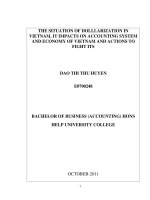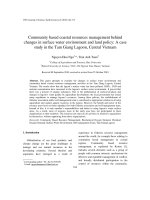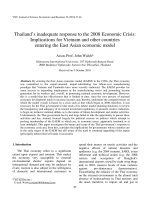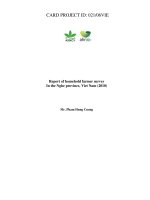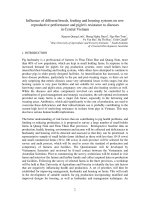Pig breeds (GF24) introducing to central vietnam and reproductive performance
Bạn đang xem bản rút gọn của tài liệu. Xem và tải ngay bản đầy đủ của tài liệu tại đây (112.76 KB, 6 trang )
D
Journal of Agricultural Science and Technology A and B
& Hue University Journal of Science 5 (2015) 457-462
doi: 10.17265/2161-6256/2015.12.002
DAVID
PUBLISHING
Pig Breeds (GF24) Introducing to Central Vietnam and
Reproductive Performance
Nguyen Quang Linh and Le Duc Nhanh
Department of Nutritional Diseases and Systems for Livestock and Aquaculture, Center for Incubation and Technology Transfer,
Hue University, Hue City 47000, Vietnam
Abstract: The aim of this study was to characterize the reproductive performance of new pig breed introduced to Central Vietnam.
The data were collected on farm by field studies with 30 individuals, during a period of one year to record and register productive
and reproductive indicators. The GF24 female breeding pigs imported from US for Vietnam through GreenFeed Asia were intended
for reproductive performance. Results obtained for first coming heat, first mating, first litter farrowing age, pregnancy time and dry
sow were as follows: 166.2 ± 2.94, 200.44 ± 2.14, 133.79 ± 2.29, 317.75 ± 2.19, 117.31 ± 0.31 and 8.27 ± 0.86 d, respectively. The
average number of piglets born alive and stillbirths per litter were 11.58 ± 0.52 and 0.65 ± 0.27, respectively; both traits were
affected by the parity of the sows. The individual weight at birth of piglets was 1.38 ± 0.12 kg and the number of weaned piglets was
9.58 ± 0.53. The feeding in the farms was characterized by using commercial feed (80%) and agricultural remainder (20%) as
balanced feed. As a conclusion, this breed offers a potential progress in livestock for rural and industrial areas and is a contribution to
the development of pig husbandry in Vietnam.
Key words: GF24 pig breed, reproductive performance, adaptation, Central Vietnam.
1. Introduction
Pig production systems, including backyard, free
grazing, semi-intensive and intensive, are together
developed in Vietnam, and the systems in the coming
years will increase the number of pigs and improve
productivity and meat quality by researching and
putting the formula feed to new hybrid that suits the
natural conditions of Vietnam. Rural and peri-urban
pig farming is a form of production characterized by a
low scale of activity, basically for subsistence [1].
New producers who are dedicated to this kind of
industrial pig husbandry under family usually raise
reproductive sows [2, 3]. The genetic quality will be
improved much by exotic breeds as Pietrain, Duroc,
Landrace and Yorkshire, combination breed as PIC
and now introduction of GF24 for adaptability to a
new environment to enable them to produce meat and
reproductive performance with a minimum input.
Corresponding author: Nguyen Quang Linh, Ph.D.,
research fields: animal nutrition and diseases.
GF24 is a product of collaboration between two lines’
harmonization of pig key PIC: 1050 line 1040 line.
The 1050 line has superior characteristics of fertility
with about 28 weaned/sows/year, while 1040 line is
superior in weight gain and meat quality. About
physical appearance, pigs GF24 have average
appearance, long blow, white body, back flat, erect,
small head, short muzzle, strong legs, small bones and
large thigh muscles grow vertically. GF24 is a new
generation line of pigs, which carries the increased
appetite gene and should grow and develop very fast
with low feed consumption, average gained of 1 kg of
meat/1.1 kg bran. GF24 pigs carry the gene for
increasing litter size and milk production, have a high
resistant to diseases and also carry genes resistant to E.
coli. Consistent with climate and farming conditions
in Vietnam, backyard husbandry systems must be
considered as a peculiar productive stratum within the
context of national pig farming. They are unlikely to
disappear and therefore can not be ignored, and so
458
Pig Breeds (GF24) Introducing to Central Vietnam and Reproductive Performance
they must be studied in greater depth to know better
the levels of productivity and the limitations to
achieving higher rates of production. In intensive pig
farms, it is common practice to routinely evaluate the
system in the pursuit of greater productivity. By the
way, there is a lack of information concerning levels
of productivity in region and country [4]. Yet, this
type of pig husbandry has many owners. Performance
in a pig enterprise should be guided by specific target
levels, with the aim of obtaining higher profits
through an adequate business control. When pig
farmer of small farm scale want to have a wide vision
of the farm and regional productivity, it is essential to
apply methods to illustrate this through the productive
indicator analysis [1, 5, 6]. To achieve this, the
producer needs a record, containing all information
necessary to realize such an evaluation. Householders
of pig farms in small scale generally do not have
records about quantification of animal production;
moreover, they rarely have access to technical support
to guide them in this task. The study aimed in
investigation of a new pig breed to Central Vietnam
and introduction of the breed to communities to
increase reproductive performance and a higher
income for small scale pig farms.
2. Materials and Methods
in the farms were not included in the study. The 30
breeding stocks and gilts were allocated into five
groups, each one with six gilts on eight months of age.
Housing system is built in a closed model,
microclimate in the barn is regulated by a system of
indoor units installed in cages and fan assembly
sequence at the end of the range cage to maintain
proper temperatures in 22-26 °C, suitable wind
speeds from 1.0-1.5 m/s. Booths of sows review
rectangular cage floor paved with cement plates, the
floor pens have drainage systems stool, urine, toilet
stalls. This system of waste resulting from the barn to
the final biogas system at the waste was taken to the
reservoir.
Sows are allocated into five groups, each one with
six gilts, and arranged for easy coordination week care
and management. Nutrients and feeding regime
composed by 80% of commercial compound feed and
20% of agricultural wastes: commercial feed, 15% and
16.5% CP, 3,100 kcal and 3,200 kcal digestible
energy (DE), 5.5% ash and 14% moisture, and
agricultural wastes as sweet potato leaves, rice bran
for GF07 and GF08, respectively, are used (Table 1).
2.2 Measurements and Methods
The following parameters were registered: number
of piglets born alive, number of stillbirths, individual
2.1 Animals and Feeding
and litter weight at birth and at weaning, number of
The observations were made from January to July
weaned piglets, pre-weaning mortality, weaning age,
2015, and the production data in a small industrial
percentage of stillborn piglets, feed conversion, and
farm in Quang Binh imported 30 gilts of GF24 pig
age and weight at market. The methodology used to
breed from GreenFeed Company, origin from USA,
evaluate and characterize the “runt” pigs was
were recorded and analyzed. The type of pig prevailed
described by Refs. [4, 6]. The next reproductive
in the study was the “exotic”. The “improved” breeds
parameters were registered as following: interval from
Table 1
Diets
GF 07
GF 08
Dietary composition and feeding regime.
Moisture (%)
14.0
14.0
Gilt
CP (%)
15.0
16.5
ME (kcal/kg)
CF (%)
3,100
10.0
3,200
6.0
Pregnancy
Ca (%)
P (%)
Lysine (%)
0.9-1.5
0.6-1.2
0.8
0.9-1.5
0.6-1.2
0.9-1.5
Suckling
Dry
Feeding regime
Restricted and
Restricted (GF07)
Restricted (GF08)
Restricted (GF07)
ad-libitum (GF08)
CP: crude protein; ME: metabolizable energy; CF: crude fat; GF07: GreenFeed 07 line; GF08: GreenFeed 08 line.
Pig Breeds (GF24) Introducing to Central Vietnam and Reproductive Performance
weaning to first service, interval from weaning to
effective service, lactation period, fertility percentage,
abortion percentage, productive life span, productive
cycle and interval between farrowings.
The statistical analysis of the data consists of
central trend measurements. An analysis of variance
was performed to evaluate the effect of parity on the
number of piglets born alive and dead. The model
included parity and error with farms as replicates. For
lactating sow, on the 23rd day the weaning is
conducted, on the 20th day the caloric needs half
demand amount of 3 kg/sow, and on weaned day sows
not eat, but are injected able vitamins A, D, E of 7
mL/sow. And sows were moved through distribution
and the waiting for mating. Sows were checked and
waited for insemination of sow for the coming litter.
Each sow is mated two times and transferred to
pregnancy crate and pens for care [1], coordinating
complete of record by sow cards for herd management.
After finishing coordinate, sows are kept quiet,
restricted movement, kept in place coordination within
1-2 d, and then sorted sows are weekly distributed for
ease of management and care. Data were processed on
an Excel spreadsheet. Using some statistical
parameters to characterize the degree of concentration
as the mean, mean error and confidence level at P <
0.05.
3. Results
3.1 Reproductive Indicators of GF24 Sows
The results from the reproductive criteria of sows
are shown in Table 2. The variables of sows GF24 and
assessing fertility indicated that first mating came
Table 2
459
early but with a higher body weight 133.75 ± 2.19 kg
at age of 200.44 ± 2.14 d, and feed consumption
reduced for whole periods in each cycle, thereby
improving economic efficiency for farmers or
investors. Age of first estrus of GF24 is 166.20 d.
3.2 Estrus and Insemination
Age of first insemination of study subjects of GF24
is 200.44 d. It is lower than the set target (209 d) of
the GreenFeed Company. This difference is due to the
techniques applied in animal husbandry and ignores for
first two estrus. The duration of standing estrus is
often shorter in gilts compared to sows, but the effect
of sow on estrus and ovulation timing is largely due to
differences in weaning-to-estrus interval between
parity groups. A sow’s weaning-to-estrus interval is
inversely related to the duration of estrus and onset of
estrus-to-ovulation interval; sows who have short
weaning-to-estrus intervals tend to have a long
duration
of
estrus
and
a
long
onset
of
estrus-to-ovulation interval and vice versa.
Multiparous sows were expected to have a shorter
duration of estrus and onset of estrus-to-ovulation
interval. However, about the weaning-to-estrus
interval, Koketsu [7] reported a shorter duration of
estrus cycle for litter 1 and 2, compared to litter 3 of
sows (55 h vs. 62 h; P < 0.001). Table 2 also showed
sows after weaning and litter one baby tended shorter
duration of estrus, and had a shorter onset of
estrus-to-ovulation interval than that of sows after
litter four birth piglets (52.3 h vs. 54.6 h, and 38.7 h vs.
42.8 h; P < 0.01, respectively). Collectively, these data
suggest that parity does have some affect on duration
Reproductive indicators of GF24 sows (n = 30).
Variables
Mean
Standard error
Probability
First coming heat age (d)
First mating age (d)
First body weight (kg/head)
First litter age (d)
Pregnancy period (d)
Dry sow (d)
166.20
200.44
133.79
317.75
117.31
8.27
2.94
2.14
2.29
2.19
0.51
0.86
0.060
0.043
0.047
0.044
0.006
0.010
460
Pig Breeds (GF24) Introducing to Central Vietnam and Reproductive Performance
of estrus and onset of estrus-to-ovulation interval that
is not related to weaning-to-estrus interval.
Differences in weaning-to-estrus interval, duration of
estrus and onset of estrus-to-ovulation intervals
between primiparous and multifarious sows may be
large enough to have important implications for the
artificial insemination protocols of parity-specific
herds. The volume of first insemination is also a factor
affecting the productivity and quality of cubs. The
study groups finding was 133.79 kg/head, while the
GreenFeed Company’s qualified set was 130-140
kg/head. First calving age have a close relationship
with the age of first sexual activity, age of first
breeding and insemination success rate for the first
time. So, the first calving age is determined by age of
first insemination; the insemination at early age, the
breeding success rate is high, however increases
duration of use sows (up to 317.75 d). The
successfully mated time of weaning is an indicator
affecting calving interval and reproductive
performance of sows. The successful mating after
weaning depends largely on the condition of stud and
the body condition of sow before breeding, because
too fat or too skinny will lead to slow up on pregnancy
results. Time of successful insemination after weaning
depends on care, sanitation and pens of sows,
especially in a period of several days after birth,
because it affects the recovery of the reproductive
organs of sows. In addition, time of insemination after
successful weaning depends on mating techniques to
timely coordinate appropriate increase in pregnancy
rates. To shorten the time of successful drying sows
Table 3
and decrease the culling rate for sows in pig farms,
farmers should have concentrated the time of feeding
and care after prolonged weaning sows and
individuals who often get infections reproductive
organs. Previous scientific results show that time after
successful mating of weaning sows GF24 is 8.27 d.
3.3 Gestation and Farrowing
Gestation is characteristic for the species. But
besides determined by genetic factors, pregnancy is
also affected by care regime. Study of pregnancy period
is 117.31 d. These results are suitable with gestation
period of sow, as 110-118 d average [8, 9].
3.4 Reproductive Performance
To assess the fertility of sows GF24, keep track of
details on the sow herself, while also monitor
reproductive performance on the cubs of the study
subjects. The research results are presented in Table 3.
The average number of piglets born alive and
stillbirths per litter were 11.58 and 0.65, respectively.
Both traits were affected by the parity of the sows.
The individual weight at birth was 1.38 kg, the
number of weaned piglets was 9.58, the age and
weight at marketing were 210 d and up to 86 kg,
respectively.
4. Discussion
The numbers of newborns, i.e., the total of all the
offspring, include number of born alive, litter size and
stillbirths. This criterion can assess whether the egg is
fertilized, the technical level and stud foster care for
Reproductive performance variables of GF24 sows (n = 30).
Variables
Mean
Standard errors
Probability
Average number of piglets born alive (number)
11.58
0.52
0.01
Average number of stillbirths (number)
0.65
0.27
0.01
Weight at birth average (kg/head)
1.38
0.12
0.00
Weight at weaning average (kg/head)
6.59
0.19
0.00
Average number of weaning piglets (number)
9.58
0.53
0.01
Lactation period (d)
23.27
0.36
0.01
Pig Breeds (GF24) Introducing to Central Vietnam and Reproductive Performance
pregnant sows. The number of piglets born more or
less depends on whether the zygote is formed and
capacity of feeding pregnant sows [1, 10]. The number
of newborns/drive is the target of indirect selection to
improve the number of piglets born alive per litter. In
this study, the numbers of newborn are 11.58 piglets
per litter. It is relatively low compared with the
GreenFeed Company’s standards given as 13 piglets.
This difference may depend on technical conditions
and ranches.
Number of piglets alive after 24 h is an indicator to
assess the viability of the fetus, breeding capability of
fetal pig and technical custody of pregnant sows of
breeding farms. Research results in Table 3 shows the
number of piglets alive after 24 h was 11.58 piglets
per litter; it was lower than the company’s standard of
12.45 piglets per litter and Landrace breed of 11.65
piglets per litter [11, 12] and higher than crossbred F1
(between Yorkshire and local Mong Cai breed) of
11.01 piglets per litter [5]. The number of breeding
pigs selected to study was 10.24 piglets per sow, and
the company’s standard is 12 piglets per sow. Birth
weight per litter related to the born alive and
nutritional care regime affects the ability of piglet
weight gain during the maternal period and
post-weaning period.
Birth weight on target groups GF24 is 1.38
kg/piglet, and criteria of the company are 1.3-1.4
kg/head as average weaning weight to help assess the
strength of the growth of the piglets in under mother
period and the maternal ability of sows. Weaning
weight depends on the uniformity of the piglets at
birth, survival rate, uniformity at weaning, weaning
weight, number of weaned piglets per litter and
technical nursing care. Weaning weight reached of
6.59 kg/head, which is still lower than other exotic
breeds in Vietnam [5, 6].
The number of weaned pigs in experiments on
GF24 is 9.58 piglets/litter. Number of weaned pigs is
as a important indicator to assess present capabilities
of the selected animal conservation. Piglets are
461
sensitive to environmental impacts. To minimize the
loss of piglets, his mother must have the appropriate
technical measures, particularly preventive hygiene
and stay warm for piglets. The mortality rate at birth is
a lower than other breed. In addition, mortality and
birth born type depend on specific regulations of each
ranch. For this research, the specified volume of
neonatal piglets alive after 24 h was selected from the
householder’s feedback of 0.9/piglet or more, not
deformed piglets. Piglet mortality rate during
follow-mother in this study was 0.65%. Percentage of
piglets’ death during follow-mother said the number
of newborn piglets alive at weaning. This indicator
significantly affects economic efficiency in livestock
breeding sows through the weaning amount sold [1, 8,
10]. Percentage of piglets’ death during follow-mother
depends greatly on the care process of the selected
piglets reared in suckling period. The piglets also
depend on sows ability to care for new born piglets
and the design sow crates for sow just enough to stand
up and lie down so happens status sow piglets crushed
the piglets to death [9, 11]. In addition, the male
piglets at this stage must be castrated after 10 d of age,
and in the following days given creeffeed for piglets
to restrict pathogens [9, 13-15]. Adjust the appropriate
temperature for the sow and piglets in the demand for
higher heat for piglet sow a lot [16]. When the
temperature drops very low, piglet diarrhea are prone
to die, and the surviving piglets were treated, but also
affected very long during the growth and development
of pig later. These factors affect the rate of maternal
death, time to weaning (days) affects approximately
suckling interval and the suckling interval must
impact on two factors that shorten the weaning date
and time successfully inseminated after weaning.
Shortening the number of weaning days contributes to
reducing the gap between the two parities, thereby
increasing the parity of the sow in a year while
reducing the cost of breeding and increasing economic
efficiency. Weaning time for this study of GF24 is
23.27 d.
Pig Breeds (GF24) Introducing to Central Vietnam and Reproductive Performance
462
5. Conclusions
There were obvious adapted abilities of the new
GF24 pig breed introduced to Central Vietnam, and
reproductive performance in the local feeding
combination with commercial feed under husbandry
conditions in the areas were higher than native and
crossbreds.
Reproductive aspects were adapted in small scale
pig farms in Central Vietnam under condition of
semi-intensive pig production systems. On the
positive side, the use of recycled wastes is an
important contribution to sustainable resource
utilization, as well as being a low cost system for the
producer and a higher benefit.
[7]
[8]
[9]
[10]
[11]
References
[1]
[2]
[3]
[4]
[5]
[6]
Duyet, H. N., Nguyen, Q. L., Cargill, C., and Nguyen, N.
P. 2010. “Effect of Using Creep Boxes for Piglets on the
Reproductive Performance of Mong Cai Sows Kept in
Smallholder Farms in Thuy Phuong Commune, Thua
Thien Hue Province.” In Proceedings of the 14th Animal
Science Congress of the Asian-Australasian Association
of Animal Production Societies (AAAP), 535.
Eisen, J. J., Kanis, E., and Kemp, B. 2000. “Sow Factors
Affecting Voluntary Feed Intake during Lactation.”
Livest. Prod. Sci. 64 (2-3): 147-65.
Elbers, A. R., Vernooy, J. C., Van Den Broek, J., and
Verheijden, J. H. 1996. “Risk of Recurrence of Repeat
Breeding in Sows with a Repeat Breeding in the First
Parity.” J. Anim. Sci. 74 (10): 2327-30.
Vesseur, P. C., Kemp, B., and Den Hartog, L. A. 1994.
“Factors Affecting the Weaning-to-Estrus Interval in the
Sow.” J. Anim. Physiol. and Anim. Nutr. 72: 225-33.
Linh, Q. N., Tu, L. C., and Koops, W. J. 1999. “The Use
of Pig Large White, Mong Cai and Their Crossbreeds in
Different Farming Systems in Central Vietnam.” M.Sc.
thesis, Wageningen Agricultural University, The
Netherlands.
Linh, Q. N., Hoang, N. D., Nguyen, N. P., Cargill, C.,
and Trott, D. 2010. “Influence of Different Breeds,
Feeding and Housing Systems on Sow Reproductive
Performance in Central Vietnam.” In Proceedings of the
13th Animal Science Congress of the Asian-Australasian
[12]
[13]
[14]
[15]
[16]
Association of Animal Production Societies (AAAP),
212.
Koketsu, Y. 1999. “Assessment of Sows Mating Efficacy
during the Low Productive Period after Early Weaning: A
Field Study.” Therio. 51 (8): 1525-32.
Jindal, R., Cosgrove, J., Aherne, F. X., and Foxcroft, G.
R. 1996. “Effect of Nutrition on Embryonal Mortality in
Gilts: Association with Progesterone.” J. Anim. Sci. 74
(3): 620-4.
Pope, W. F. 1994. “Embryonic Mortality in Swine.” In
Embryonic Mortality in Domestic Species, edited by Zavy,
M. T., and Geisert, R. D. Boca Raton, FL: CRC Press,
53-77.
Tsuma, V. T., Einarsson, S., Madej, A., Kindahl, H., and
Lundeheim, N. 1996. “Effect of Food Deprivation during
Early Pregnancy on Endocrine Changes in Primiparous
Sows.” Anim. Reprod. Sci. 41 (3-4): 267-78.
Jindal, R., Cosgrove, J. R., and Foxcroft, G. R. 1997.
“Progesterone Mediates Nutritionally Induced Effects on
Embryonic Survival in Gilts.” J. Anim. Sci. 75 (4):
1063-70.
Kirkwood, R. N., Baidoo, S. K., and Aherne, F. X. 1990.
“The Influence of Feeding Level during Lactation and
Gestation on the Endocrine Status and Reproductive
Performance of Second Parity Sows.” Can. J. Anim. Sci.
70: 1119-26.
Le Cozler, Y., Dagorn, J., Dourmad, J. Y., Johansen, S., and
Aumtre, A. 1997. “Effect of Weaning-to-Conception
Interval and Lactation Length on Subsequent Litter Size
in Sows.” Livest. Prod. Sci. 51: 1-11.
Tantasuparuk, W., Lundeheim, N., Dalin, A. M.,
Kunavongkrit, A., and Einarsson, S. 2000. “Reproductive
Performance of Purebred Landrace and Yorkshire Sows
in Thailand with Special Reference to Seasonal Influence
and Parity Number.” Therio. 54 (3): 481-96.
Tantasuparuk, W., Dalin, A. M., Lundeheim, N.,
Kunavongkrit, A., and Einarsson, S. 2001. “Body Weight
Loss during Lactation and Its Influence on
Weaning-to-Service Interval and Ovulation Rate in
Landrace and Yorkshire Sows in the Tropical
Environment of Thailand.” Anim. Reprod. Sci. 65 (3-4):
273-81.
Koketsu, Y., and Dial, G. D. 1998. “Interactions between
the Associations of Parity, Lactation Length and
Weaning-to-Conception Interval with Subsequent Litter
Size in Swine Herds Using Early Weaning.” Prev. Vet.
Med. 37: 113-20.


